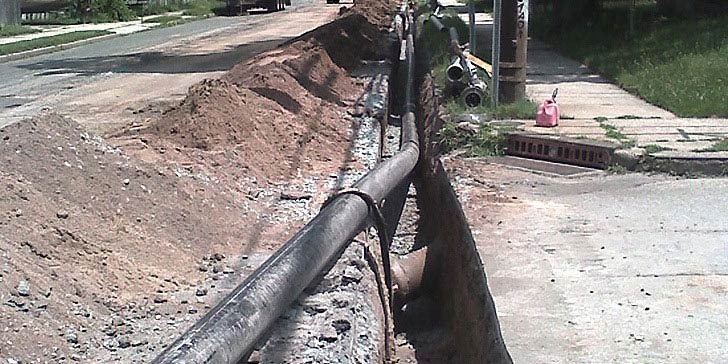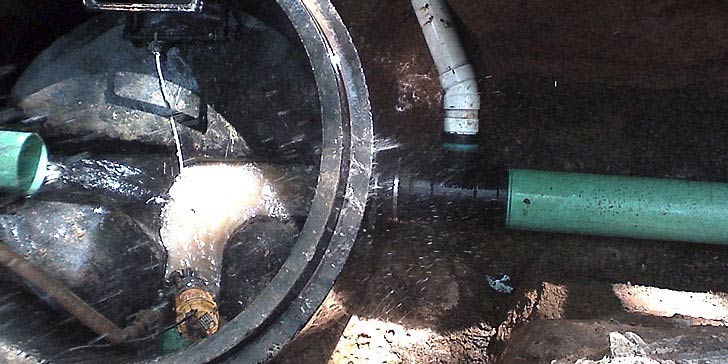Residential Sewer Repair Services - New Jersey,
Monmouth, Middlesex County
ICUNJ offers excellent high-pressure drain-jetting service in Monmouth County, NJ
We Offer Free Video Inspections!
ICUNJ has led the industry in implementing innovative solutions. No two
projects are the same, so our dedicated team of industry experts work
with you to develop customized solutions to meet the most
challenging conditions,for trenchless sewer repair in NJ. Contact us today for all things residential sewer line repair in Middlesex, and Monmouth County, NJ.
See how we get the job done.
Positive Pitch
 Positive pitch on sanitary sewer pipe is required to properly transport both solid and liquid waste. Exaggerated (too much) pitch causes liquids to travel quickly while leaving solids behind to congest the line. Not enough pitch also results in solids congesting the line. Proper pitch is normally considered ¼" drop for every foot horizontal (check with your local plumbing official for acceptable tolerances).
Positive pitch on sanitary sewer pipe is required to properly transport both solid and liquid waste. Exaggerated (too much) pitch causes liquids to travel quickly while leaving solids behind to congest the line. Not enough pitch also results in solids congesting the line. Proper pitch is normally considered ¼" drop for every foot horizontal (check with your local plumbing official for acceptable tolerances).
Root Intrusion


Roots are a very common problem for sewer lines constructed prior to the early 1980's. This is because these sewer lines were built using VCT (vitreous clay tile) pipe. Clay tile pipe is a ceramic product dating back to the Roman aqueducts and is an ideal material for transporting water since it is inert. Clay tile pipe is also an ideal material for use in difficult environments since it is amazingly strong, having nearly a 3/4" thickness, and is virtually impervious to deterioration from normal use. However, its multiple joints are a downside. Clay tile pipe tends to leak water at the joints, making a wonderful water source for thirsty trees and shrubs.
Read More About Tree Root Instrusion
Sag or Belly

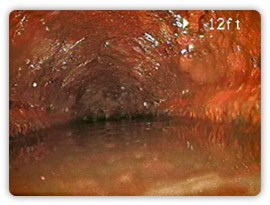
A Sag or Belly is where the sewer pipe has lost positive slope going to its destination. Typically, sewers flow by gravity to where they tie into the city's main sewer. If a line is properly installed, it will have a positive slope for the entire duration of its distance. Where a portion of the line has settled, the rate at which liquids travel through it is significantly reduced. The reduced velocity of liquids allows the area to collect solids, eventually obstructing the line.
Read More About Sag or Belly
Separations, Collapse & Cracks

 Separations, Collapse & Cracks in a sewer pipe can occur from a variety of sources, including poor original installation, poor soil bedding, root penetration or structural deterioration due to the age of the pipe. In addition to structural impacts, these conditions allow exfiltration of household waste and infiltration of clean groundwater into the wastewater sewer system.
Separations, Collapse & Cracks in a sewer pipe can occur from a variety of sources, including poor original installation, poor soil bedding, root penetration or structural deterioration due to the age of the pipe. In addition to structural impacts, these conditions allow exfiltration of household waste and infiltration of clean groundwater into the wastewater sewer system.
"Off-set" conditions occur when connected sections of pipe do not line up perfectly causing pipes to sits lower or off to the side of the connecting pipe.
Underground pipes are installed in sections or segments ranging from 2' to 20' or more. Sewer lines built from the 1800's up to the mid 1980's were constructed using a large number of short sections, typically 2' to 4' in length, of VCT (vitreous clay tile) pipe. These sewer lines are particularly subject to off-sets due to their large number of joints. During construction, the joints were sealed with products such as concrete, coal tar, oakum, rubber gaskets, and on occasion, nothing at all. Over time, these sealants erode away, allowing the pipe to then settle down. Offset joints can cause debris to build up on the joint that can eventually lead to backups. Also, if the joint is offset enough that soil is exposed around the edges of the pipes, the surrounding soil can erode into the pipe and be washed away, eventually causing voids to occur around the outside of the pipe and possibly become sink holes. Offset joints are not watertight and can allow infiltration of clean groundwater into the wastewater sewer system.Read More About Separations, Collapse & Cracks
Debris / Grease
Debris / Grease debris can build up in a side sewer if there are structural defects or obstructions in the pipe (such as sags, roots or offset joints) that obstruct the flow of the sewer and if inappropriate items are flushed or poured down the drains. Or, if pipes are constructed at slopes less than the recommended ¼-inch drop per foot of pipe, the liquids won't be moving fast enough to carry away the solids in the pipe. If debris build up is severe enough, it can eventually fill a pipe and cause backups or slow-draining sewers. Examples of items that do not degrade like toilet paper and should not be flushed down a drain (even though they may be advertised as flushable) include baby wipes, disinfectant wipes, paper towels, egg shells, coffee grounds, dental floss, toilet bowl scrub pads, feminine hygiene products and grease. Even very hot grease cools quickly once it reaches an underground pipe and sticks to the walls of the sewer. Over time, grease can cause a sewer to either drain very slowly or cause a complete blockage of the side sewer. Grease is one of the more common causes of backups and slow-draining side sewers.
Read More About Debris / Grease
Methods to Eliminate Defects in Sewers
This section describes various methods available for repairing, replacing, or rehabilitating an existing sewer. Every sewer is unique and not all methods are suitable for all circumstances. It is always important to work with a sewer contractor experienced with the particular kind of construction to determine the suitability for each sewer on an individual basis and to obtain cost estimates for the various methods as they may vary greatly for each project.
Pipe Bursting:
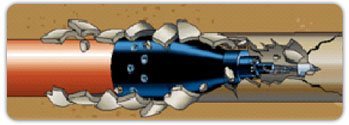 Pipe bursting is a method of replacing buried pipelines (such as sewer, water, or natural gas) without the need for a traditional open cut trenching. One or more pits are required to launch and receive the new pipe. Pipe bursting may also be used to expand pipeline carrying capacity by replacing smaller pipes with larger ones, or "upsizing." Extensive proving work by the gas and water industries has demonstrated the feasibility of upsizing sewer, gas and water mains and laterals.
Read More About Pipe Bursting
Pipe bursting is a method of replacing buried pipelines (such as sewer, water, or natural gas) without the need for a traditional open cut trenching. One or more pits are required to launch and receive the new pipe. Pipe bursting may also be used to expand pipeline carrying capacity by replacing smaller pipes with larger ones, or "upsizing." Extensive proving work by the gas and water industries has demonstrated the feasibility of upsizing sewer, gas and water mains and laterals.
Read More About Pipe Bursting
Cured In Place Pipe (CIPP) lining:
A cured-in-place pipe (CIPP) is one of several trenchless rehabilitation methods used to repair existing pipelines. CIPP is a jointless, seamless, pipe-within-a-pipe with the capability to rehabilitate pipes ranging in diameter from 0.1–2.8 meter (4"–110"). As one of the most widely used rehabilitation methods CIPP has application in water, sewer, gas, and chemical pipelines. Read More About Cured In Place Pipe
Open Cut Construction:
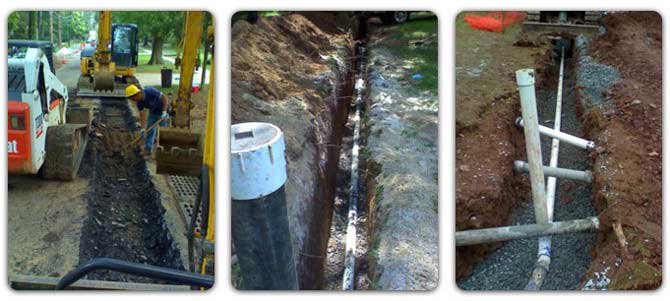
This method of construction is the typical dig and replace that most people are familiar with. This is the most common method of repairing side sewers and consists of digging up the old pipe and replacing it with new pipe. Open cut may be less suitable for areas where there are significant surface improvements that a property owner wants to avoid disturbing and that are costly to replace or when side sewers are fairly deep.
Read More About Open Cut Construction
Spot Repairs:
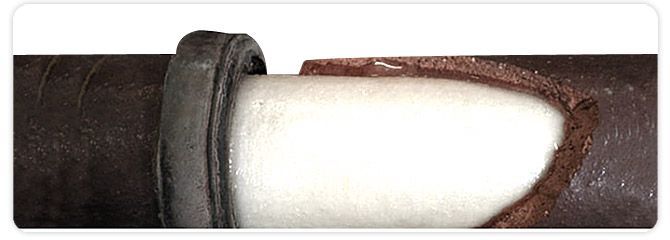
If the majority of a pipe is good condition with little or no defects, a spot repair may be the most suitable and cost effective method for repair. The property owner should consider a full sewer replacement or rehabilitation if there are multiple defects throughout the pipe. It is generally less costly to hire a contractor once than to have a contractor mobilize to a site multiple times with repeated spot repairs.
Read More About Spot Repairs
High Pressure Jetting:
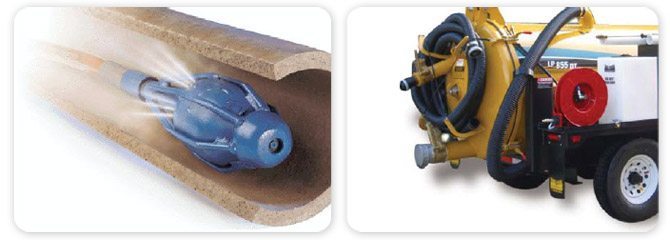
High Pressure Jetting to perform pipe cleaning is commonly performed by a technique known as sewer jetting. Sewer jetting is the application of streams of high pressure water for use within pipes for cleaning & debris removal. Water at the correct high pressure can cut roots, dissolve blockages, emulsify grease and soaps while spray washing pipe wall surfaces. As part of the jetting process, the water from the nozzle can also wash away accumulated dirt or debris on the bottom of the pipe at the same time.
For sewer jetting, a jetting nozzle is attached to the end of a length of high pressure hose with the other end connected to a high pressure water pump. Jetting nozzles have small precision machined orifices or jets to restrict water flow from the jetting pump thus causing high pressure to build within hose. As the pressurized water is expelled from the nozzle jets it reverts from pressure to velocity (speed) creating thrust that allows the nozzle to pull the jetting hose. With the system pressurized, high pressure jetting hose coiled on a hydraulic powered hose reel is released by the operator who controls the travel speed and distance of the nozzle up the pipe. Pressurized water expelled from the nozzle jets cleans debris, removes pipe blockages or roots from the inside of the pipe while traveling through the pipe. Optimum cleaning is achieved when the hose is being rewound onto the hydraulic reel. During this action, water from the nozzle jets effectively forms a curtain or wall of high pressure water that forces (or rakes) the debris downstream. Sewer jetting technology can be applied to clean all size pipe diameters with the appropriate size of high pressure jetting unit. Read More About High Pressure Jetting
Snaking:
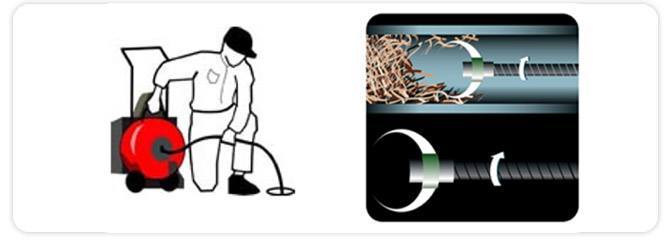 Snaking is more commonly performed to eliminate large objects accidentally introduced into a sewer system, non-biodegradable napkins, grease, oil or soap residue that collects on the pipe sidewalls, and roots. A drawback to this method is the damage that may occur in Plastic pipe, Orangeburg pipe and Deteriorated pipe regardless of composition. Snaking to eliminate roots is primarily a temporary solution and requires ongoing maintenance that may be frequent depending on how aggressive the vegetation is.
Read More About Snaking
Snaking is more commonly performed to eliminate large objects accidentally introduced into a sewer system, non-biodegradable napkins, grease, oil or soap residue that collects on the pipe sidewalls, and roots. A drawback to this method is the damage that may occur in Plastic pipe, Orangeburg pipe and Deteriorated pipe regardless of composition. Snaking to eliminate roots is primarily a temporary solution and requires ongoing maintenance that may be frequent depending on how aggressive the vegetation is.
Read More About Snaking

